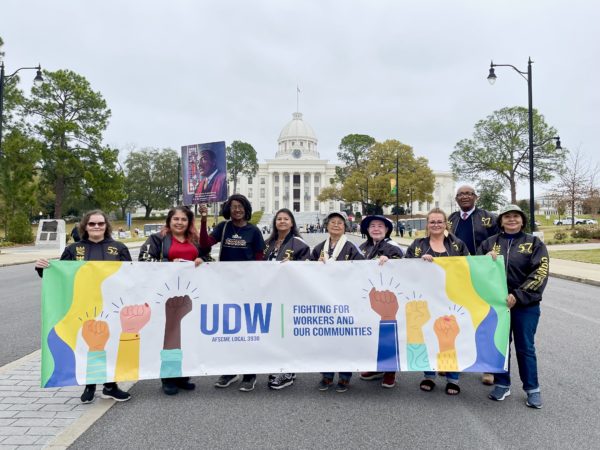“Our experience in Montgomery was a clear reminder that we have come so far in our fight for our rights, but we have so much further to go,” said UDW Secretary-Treasurer, William Reed.

On March 10, UDW members gathered in Montgomery, Alabama to walk an 11-mile leg of a 50-mile march in honor of the 57th anniversary of the Selma-to-Montgomery march, originally led by Dr. Martin Luther King, Jr. and thousands of non-violent demonstrators fighting for voting rights.
But first, we had a lot to learn.
To kick-off our trip, we trekked through rain and cold winds to visit some of Montgomery’s most historic sites and pay our respects to the incredible leadership and sacrifice that occurred throughout the city during the Civil Rights Movement. During our time in Montgomery, we took the time to make connections across centuries and learn not only about this country’s history, but about the roots of domestic labor, its ties to slavery and people of color, and why it continues to be undervalued today.
On our first day in the city, we participated in a walking tour that highlighted the history of the transatlantic slave trade, its transition into domestic slave trade, and Alabama’s role in its growth. We visited the Riverfront which was largely responsible for the growth of the domestic slave trade because of the newer means of transportation available, such as steamboats and the nearby railroad. We also walked down Commerce Street and visited locations that served as slave depots and the auction blocks where hundreds of thousands of enslaved people were sold along with land and livestock.
“I felt profound sadness to know how Black people were oppressed and that white people took joy out of doing such horrible things,” said District 7 Vice Chair Maria Isabel Serrano. “It hurt to see generations upon generations of pain, because I know that hearts don’t ever fully heal from such things.”

We began the civil rights portion of our tour at the bus stop where Rosa Parks was arrested for refusing to give up her seat to a white man, sparking the 1956 Montgomery Bus Boycott, a major catalyst for the Civil Rights Movement. As we stood at the Rosa Parks statue, we learned that Black domestic workers made up the bulk of bus riders and were essentially the backbone of the boycott. Without the support, defiance, and dedication of our fellow domestic workers, the Montgomery Bus Boycott would have failed.
The tour continued through Dexter Avenue Baptist Church and the parish where Dr. Martin Luther King, Jr. and his family lived while he was the church’s pastor. Established in 1877 by freedmen and free people of color, the church served as a meeting place for civil rights organizers while planning the Montgomery Bus Boycott.
We concluded our historical walking tour at the Civil Rights Memorial, a memorial to 41 individuals who were killed by white supremacists between 1955-1968. At the center of the memorial stood a flattop fountain with the names, dates of death and manner of death engraved on it. We stood over the circular fountain and read every name, date, and manner of death, and reflected on the unnecessary violence Black folks endured while fighting for their humanity.

The next day, we visited three museums: the Legacy Museum, the National Memorial for Peace and Justice, and the Freedom Riders Museum.
The Legacy Museum provided a comprehensive history of our country from the transatlantic slave trade to the emergence of over-incarceration in the 20th century. Founded by Bryan Stevenson, the museum was built with the intention to help people understand the pain, the suffering, and the truth behind our country’s history: We interacted with holographic projections of enslaved children, saw jars filled with dirt from hundreds of locations where lynchings took place across the U.S., and listened to recorded interviews with Black people unjustly put behind bars.
We then headed to a memorial to the more than 4,400 Black people who were lynched in America between 1877 and 1950, the National Memorial for Peace and Justice. While there, we read the stories behind some of the lynchings, including one of a domestic worker named Eliza Woods who was falsely accused of poisoning her employer’s wife. Although her employer later confessed to killing his wife, Eliza was dragged from her cell by local townspeople and lynched. The museum also paid tribute to the Black domestic workers who made the Montgomery Bus Boycott possible, with three statues in their honor.

The last museum we visited was the Freedom Riders, which recounted the stories of more than 400 riders, both Black and white, who risked their lives to travel to the deep South and violate Jim Crow laws in order to challenge a segregated interstate travel system. At the museum we saw various editions of “The Green Book,” a travel guide that enabled Black travelers to find lodgings, businesses, restaurants, and stores that would serve them, and read various stories detailing the rider’s journeys and the extreme violence they faced.
The two days of educational and historical background fired us up for one of the trip’s highlights—commemorating the 57th anniversary of the Selma-to-Montgomery March. We led the fourth leg of the march in support of voting rights alongside various unions, including the AFL-CIO and AFSCME, and hundreds of supporters from around the country. The march was a total of 50 miles through a span of 5 days from Selma to the steps of Alabama’s State Capitol in Montgomery. Each leg of the march was led by community organizations, including the National Action Network, Black Voters Matter, the NAACP Legal Defense Fund and Women’s Roundtable.

A few of us, including UDW Vice President Astrid Zuniga, completed all 11 miles of the march that day.
“I wanted to march as much as I could because it was my way of honoring the lives and the struggles of the original foot soldiers, even though I know that this is only a sliver of what they experienced in the 60s,” Astrid said. “The blisters and tiredness are only a small portion of the pain and hardships civil rights leaders and people of color experienced during that time.”
The march concluded on Friday, March 18, as we walked the last steps alongside our fellow unions and marchers and gathered on the steps of the Alabama State Capitol in Montgomery for a special rally. The speakers, including UDW Executive Director Doug Moore, spoke out against voter suppression and the road that awaits us in our fights for civil rights and equity for all.
“The work of ensuring the right to vote is far from over,” said Doug. “We are battling the voices of hate that want to disenfranchise voters of color. Our people were harassed and beaten for fighting for the right to vote and they are not about to take it away from us now. When we vote, we vote for equity. We vote for justice. We vote for the people—all people.”
The days we spent together in Montgomery were heavy with grief and reflection.
“Our experience in Montgomery was a clear reminder that we have come so far in our fight for our rights, but we have so much further to go,” said UDW Secretary-Treasurer William Reed. “The pain that comes from remembering what it was like to see my own family members lynched or being rejected from eating at certain establishments still remains, but it’s really nice to see that the torch for change is being carried on.”

Through our time in Alabama, we were reminded that our work as care providers is the backbone of this country’s economy and that we have the power to create change. Our voices are louder, stronger, and more impactful when we come together and speak up for our rights. We are important; our work is invaluable; and the roots of our power and passion for change are deep, strong, and still expanding. Our foundation is strong and so is our will for change.


